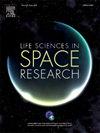Lunar dust induces minimal pulmonary toxicity compared to Earth dust
IF 2.8
3区 生物学
Q2 ASTRONOMY & ASTROPHYSICS
引用次数: 0
Abstract
Humans are returning to the moon and understanding the toxicity of lunar dust is crucial for successful missions. Apollo mission reports suggest that lunar dust poses significant inhalation risks. Previous studies on lunar dust simulants have shown tissue and cellular damage in the lungs. This study focuses on two new simulants, LMS-1 and LHS-1, which closely replicate the lunar dust of the mare and highland regions of the moon. BEAS-2B and A549 cells were treated with unprocessed LMS-1 and LHS-1 (100µg/ml, 1000µg/ml and 5000µg/ml). The simulants were processed to isolate particles ≤2.5 µm, allowing a direct comparison to Earth dust (airborne particulate matter). BEAS-2B and A549 cells were treated with processed simulants and Earth dust (10µg/ml, 50µg/ml, and 100µg/ml) for 48 and 72 h. Inflammation was measured by measuring IL-6 and IL-8 using ELISA and cell viability was measured using a trypan blue exclusion test. A time- and dose-dependent increase in IL-8 and IL-6 production by LMS-1 and LHS-1 exposure was found only in BEAS-2B cells. A dose-dependent decrease in cell viability was found in both BEAS-2B and A549 cells with lunar dust simulant exposure. Particles ≤2.5 µms cause greater cell death than particles ≤1000µm. However, Earth dust induced greater cytokine release and was more toxic than lunar dust simulants. Lunar dust simulants did not increase SOD2 gene expression, indicating no increases in oxidative stress in either cell type. Therefore, our results suggest that lunar dust simulants are not highly toxic dusts, but rather a physical irritant. Future studies are needed to confirm the relative toxicity and irritant capacity of other lunar regions simulants.
与地球尘埃相比,月球尘埃的肺毒性最小
人类正在重返月球,了解月球尘埃的毒性对任务的成功至关重要。阿波罗任务报告显示,月球尘埃有严重的吸入风险。先前对月球尘埃模拟物的研究表明,肺部组织和细胞受损。这项研究的重点是两个新的模拟装置,LMS-1和LHS-1,它们紧密地复制了月球的海洋和高地地区的月球尘埃。BEAS-2B和A549细胞分别用未处理的LMS-1和LHS-1(分别为100µg/ml、1000µg/ml和5000µg/ml)处理。模拟物经过处理以分离≤2.5µm的颗粒,从而可以直接与地球尘埃(空气中的颗粒物)进行比较。BEAS-2B和A549细胞分别用处理过的模拟物和土尘(10µg/ml、50µg/ml和100µg/ml)处理48和72 h。采用ELISA法检测IL-6和IL-8的炎症反应,采用台锥虫蓝排斥试验检测细胞活力。仅在BEAS-2B细胞中发现LMS-1和LHS-1暴露导致IL-8和IL-6产生的时间和剂量依赖性增加。BEAS-2B和A549细胞暴露于月球尘埃模拟物后,细胞活力均呈剂量依赖性下降。≤2.5 µms的颗粒比≤1000µm的颗粒更容易导致细胞死亡。然而,地球尘埃诱导了更多的细胞因子释放,并且比月球尘埃模拟物更具毒性。月球尘埃模拟物没有增加SOD2基因表达,表明两种细胞类型都没有增加氧化应激。因此,我们的研究结果表明,月球尘埃模拟物不是剧毒尘埃,而是一种物理刺激物。未来的研究需要确认其他月球区域模拟物的相对毒性和刺激能力。
本文章由计算机程序翻译,如有差异,请以英文原文为准。
求助全文
约1分钟内获得全文
求助全文
来源期刊

Life Sciences in Space Research
Agricultural and Biological Sciences-Agricultural and Biological Sciences (miscellaneous)
CiteScore
5.30
自引率
8.00%
发文量
69
期刊介绍:
Life Sciences in Space Research publishes high quality original research and review articles in areas previously covered by the Life Sciences section of COSPAR''s other society journal Advances in Space Research.
Life Sciences in Space Research features an editorial team of top scientists in the space radiation field and guarantees a fast turnaround time from submission to editorial decision.
 求助内容:
求助内容: 应助结果提醒方式:
应助结果提醒方式:


